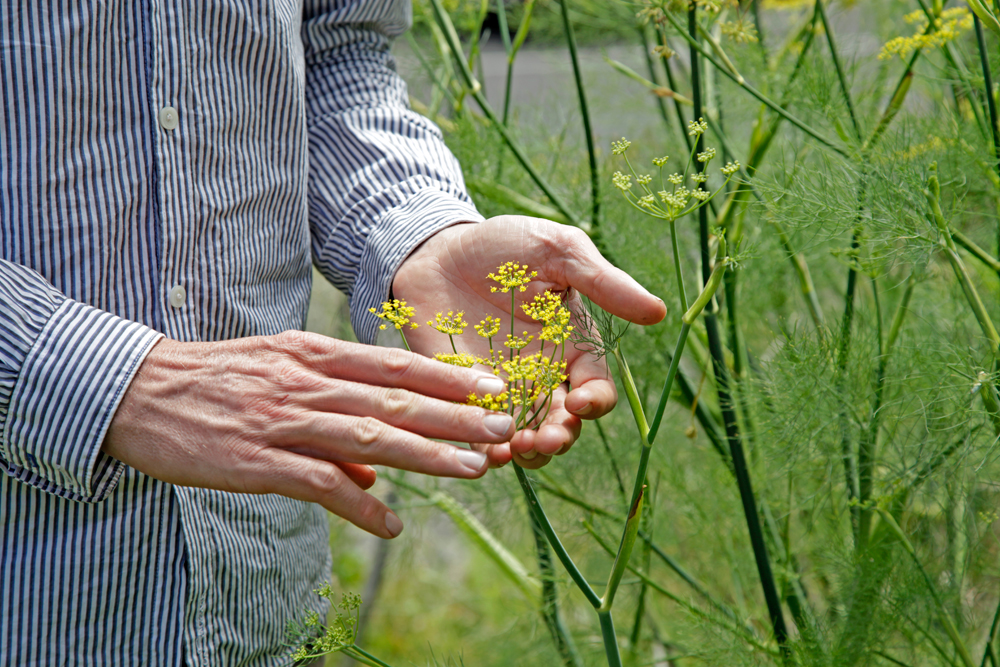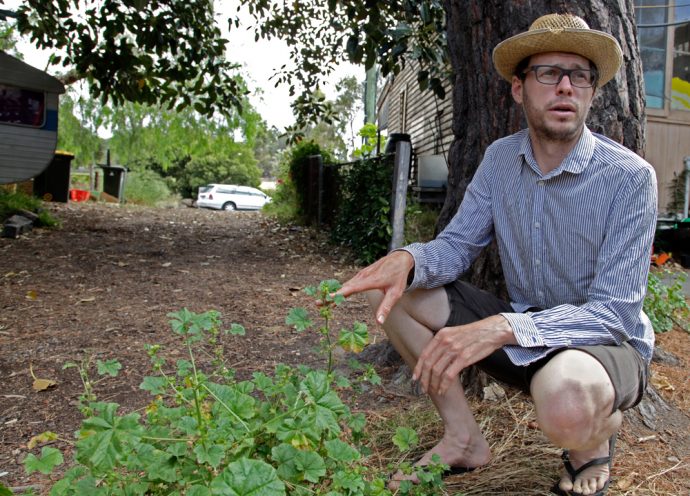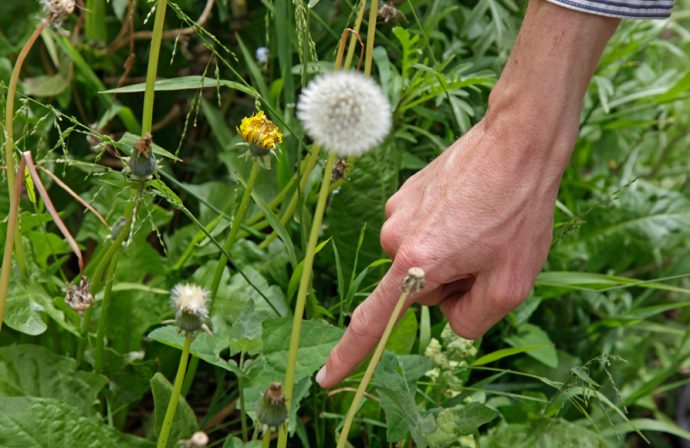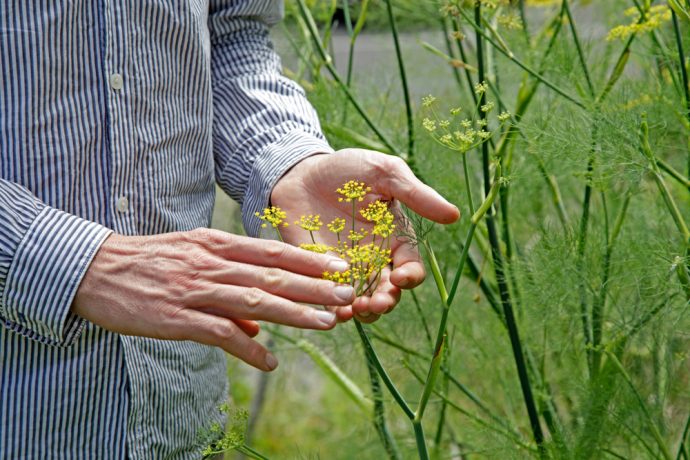The edible ecology of weeds

Weeds are often given a bad rap, as “undesirables” to be exterminated. Yet, it’s important to consider what weeds can teach us. Adam Grubb has become one of Melbourne’s leading edible weeds experts since reading herbalist Pat Collins’ book, Useful weeds at our doorstep, in 2004. With a keen interest in exploring the benefits of the many underutilised resources in our society, Adam began his own research on the ecological, medicinal and nutritional benefits of weeds. While some may consider weeds to be a niche interest, there is a growing “appetite” for knowledge on the topic. After conducting many a booked-out edible and medicinal weeds walk through his permaculture consultancy, Very Edible Gardens (VEG), Adam has teamed up with horticulturalist Annie Raser-Rowland to publish The weed foragers handbook: A guide to edible and medicinal weeds in Australia in October last year. In his funny and articulate introduction to the book, Gardening Australia’s Costa Georgiadis remembers a childhood spent foraging alongside his aunts and yiayias (grandmothers), by the Hume, the Pacific Highway or the local park. Weeds were turned into hortopita or “weed pies”. “Weeds have been a part of my life”, writes Costa. His roadside foraging expeditions “sing the song of reduced footprint, resilience and wild diversity. Every footpath, park, or highway was not seen as some sort of grass maintenance nightmare. No no. It was seen as one big wild salad bowl.”
I first went on one of Adam’s weed walks around two years ago, and have since introduced weeds into my diet (and that of many unsuspecting friends) in salads, soups, green smoothies or adding fresh greens to meals while camping. And when I stop to pick and nibble on a plant while walking the streets of Brunswick, friends often respond with a startled: “Wow, you can eat that? I see that weed everywhere. What else can you eat?”. And, so as not to misinform/poison my friends, I encourage them to go on an “official” weed walk.
My friends’ string of questions is an example of where the process of “mind weeding” begins. Many definitions simply class “weeds” as a plant considered undesirable or out of place. There is, of course, subjectivity in this definition. As Costa writes, “we will fight them in the gardens, we will fight them in the footpaths. Why? Because someone told us to. Our immediate conscious action when someone mentions the word weed is a reaction”. Adam and Annie are amongst a growing number of weed enthusiasts encouraging us to recognise that weeds, which are often very high in nutritional and medicinal value, grow in places for a particular reason. Often, the “undesirable” plants that we’re pulling out are much more nutritious and medicinal than the cultivated ones growing next to them. Mallow, for instance, is one of those weeds that springs up all through my garden and can be spotted on creek beds and nature strips across Melbourne. A relative of marshmallow and okra, mallow was considered a delicacy amongst ancient Romans – the young leaves are mild and can be eaten raw in salads or cooked as a spinach replacement, and the seed heads are high in carbohydrates, oils and proteins. In fact, mallow comes with a rave review from Roman philosopher and naturalist Pliny, who claims that “whoever shall take a spoonful of the mallows shall that day be free from all maladies”. More specifically, mallow has been recommended for use to treat burns, skin inflammations, spider bites, insect stings, bowel and urinary problems, and it’s mucilaginous qualities make it a go to plant for herbalists seeking to sooth coughs and inflamed throats and digestive tracts.

Melbourne itself takes its name from a weed you may have seen around the traps. Adam and Annie’s book quotes a 1965 article in The Age explaining that the original Melbourne, an English market town in Derbyshire, was called Melde-Bourne until AD 970 for all the melde that was growing in the area. Melde, or ‘fat hen’ as it is more commonly referred to around here, is a close relative of quinoa and is cultivated widely in northern India. This is one of Adam’s favourite weeds. Its leaves are like a nutty-tasting spinach but with a higher nutritional value – rich in vitamin C, riboflavin, calcium, antioxidants, and measures up to 43% protein by dry weight.

Urban areas are highly nutrient rich because of all the supplements we feed our gardens. Much of these nutrients run out beyond our fence lines into parks and creekways, much to the delight of weeds. After having fat hen pointed out to me during our post-pho stroll, I’ve since noticed a fair bit of it while cycling around the city. In my neighbourhood, there’s a particularly large and healthy looking patch on the corner of Lygon Street and the Park Street bike path. Adam had some fat hen growing on the north side of a tin fence at one of his houses, and this was one of the few plants that survived during the string of 40°C days during the heatwave of January 2009. This is worth noting as edible and medicinal plants that can thrive in such extreme heat may end up being quite beneficial in adapting to our warming climate.
Many plants we classify as weeds are “pioneer plants” with the ecological niche of growing first and fastest; they have a short life span while reproducing quickly in the process. If disturbance doesn’t recur, then ecological succession, involving a series of longer-lifespan plants, leads eventually to a more biodiverse steady-state ecosystem. These pioneer species tend to appear in areas that have experienced disturbance, such as land clearance, ploughing or building settlements. Weeds can therefore be seen to follow humans around. Permaculture co-originator David Holmgren has done extensive research and experimentation in Victoria using weed species to build soil health and re-vegetate barren tracts of land. The take home message from these experiments is that while weeds can have both environmental and economic impacts, if used to their strengths, weeds can provide great benefit to land management. This follows the permaculture mantra, “the solution lies in the problem”.

Like many environmentally-minded types, Adam had previously internalised the commonly held belief that native is good and introduced species are bad. Post-colonial countries, Adam believes, have the strongest anti-weed attitudes, reacting against the Europeanisation of landscapes by projecting guilt about our own ecosystem disturbance onto pioneer plant species that follow our footsteps. On a subconscious level, we identify with weeds.
Weeds are controversial. I was warned by a friend who works in conservation management at the Department of Sustainability and Environment (DSE) to tread lightly in writing this article. I have no background in conservation, nor do I know much about the life and times of many of the plant species Adam and Annie describe in their book. As a human ecologist, though, I see the issue of weeds as one that highlights our confused relationship with ecosystems around us. In spraying weeds and attempting to return things to how nature was before we came along, we land on the tension between a desire to protect nature from our human ways, along with an attachment to controlling it; dictating what is and isn’t ‘natural’. Here lies our dichotomy in which we consider humans and our endeavours as separate from (and often, “above”) the natural world; the idea that for better or for worse, our species has moved beyond the natural. But that’s a whole different article.

If we shift how we approach weeds, viewing them more as plants and part of our ecosystem, then perhaps we can spend more of our time eating, rather than yanking, spraying or poisoning. Rather than focusing on whether or not individual species are native or introduced, Adam encourages us to understand the service these pioneer plants can provide to ecological systems and cycles to undo ecological disturbance we humans have previously carried out. At the same time, we ourselves can benefit from the nutritional and medicinal value they can provide after an evening forage around the block.
Adam Grubb and Annie Raser-Rowland’s “The Weed Forager’s Handbook: A Guide to Edible and Medicinal Weeds in Australia” is published by Hyland House. You can buy it direct from the authors (and if in Melbourne, book a spot on their weed walks while you’re at it) via their website, or find it at your local bookshop.